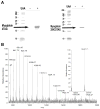Significant increase of oxidase activity through the genetic incorporation of a tyrosine-histidine cross-link in a myoglobin model of heme-copper oxidase
- PMID: 22411709
- PMCID: PMC3511862
- DOI: 10.1002/anie.201108756
Significant increase of oxidase activity through the genetic incorporation of a tyrosine-histidine cross-link in a myoglobin model of heme-copper oxidase
Abstract
Heme-copper oxidase (HCO) performs efficient four-electron reduction of oxygen to water without releasing toxic, reactive oxygen species (ROS). Essential for this function is a post-translationally modified histidine–tyrosine cross-link (Tyr-His) in its heme a3/CuB oxygen reduction center. Through the genetic incorporation of the Tyr-His ligand and CuB site into myoglobin, we recapitulated important features of HCO into this small soluble protein, which exhibits selective O2 reduction activity while generating less than 6% ROS, at more than 1000 turnovers. These results support that Tyr-His crosslink is indeed important for HCO function, and creates the exciting opportunity to rapidly evolve better HCO model proteins to achieve higher activity and selectivity, which may be suitable as alternatives to precious metal catalyst in fuel cells.
Figures





References
-
- Trumpower BL, Gennis RB. Annu Rev Biochem. 1994;63:675–716. - PubMed
-
- Kaila VRI, Verkhovsky MI, Wikstrom M. Chem Rev. 2010;110:7062–7081. - PubMed
- Yoshikawa S, Muramoto K, Shinzawa-Itoh K. Annu Rev Biophys. 2011;40:205–223. - PubMed
- Fann YC, Ahmed I, Blackburn NJ. Biochemistry. 1995;34:10245–10255. - PubMed
- Jiang JJ, Bank JF, Zhao WW, Scholes CP. Biochemistry. 1992;31:1331–1339. - PubMed
Publication types
MeSH terms
Substances
Grants and funding
LinkOut - more resources
Full Text Sources

